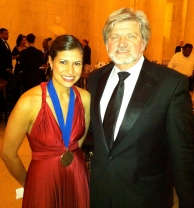
Mr. Robert Lynch
Honoring Emerging Classical Music Leaders of Color
Posted by Mar 23, 2012

Mr. Robert Lynch
I recently had the honor and pleasure of being invited to attend the Sphinx Medals of Excellence which honors “emerging Black and Latino leaders in classical music who demonstrate the following qualities: excellence, outstanding work ethic, a spirit of determination, and great potential for leadership.” The Sphinx Organization, led by Founder, President, and National Council of the Arts member Aaron Dworkin, is renowned for helping develop the best and brightest young classical musicians with the express purpose of debunking stereotypes about minorities in the classical music field. In existence for only 15 years, the Sphinx has had an enormous positive impact by reaching over 85,000 students in 200 hundred schools across the country, and awarding over $1,8250,000 in scholarships. They have also provided over $300,000 in musical instruments to young minority musicians and staged 260 orchestral performances reaching audiences of 250,000 people! Against the backdrop of the United States Supreme Court, attendees from the worlds of politics, law, and the arts gathered in our nation’s capital to be thoroughly amazed by the skill and beauty of the performances of the three recipients: clarinetist Anthony McGill and violinists Elena Urioste and Tai Murray.
Read More




 When I think of the
When I think of the 
 Lisa Phillips with Steve Wozniak
Lisa Phillips with Steve Wozniak








